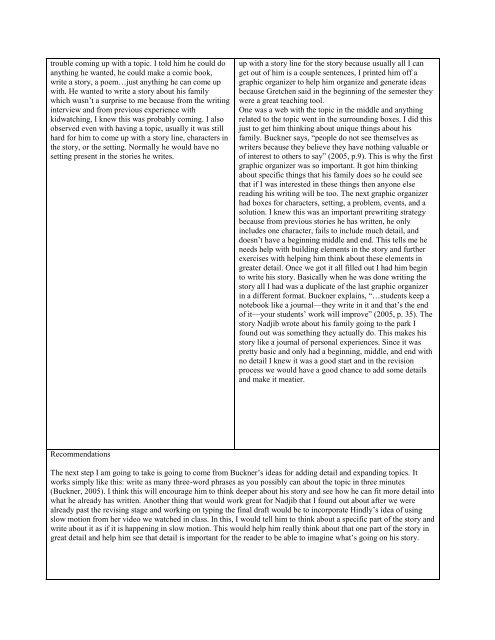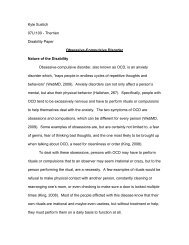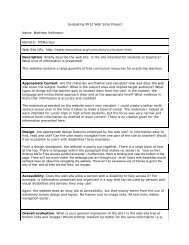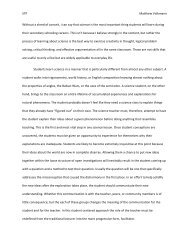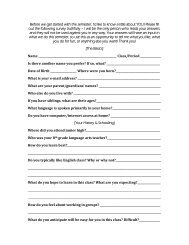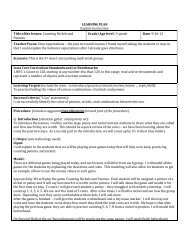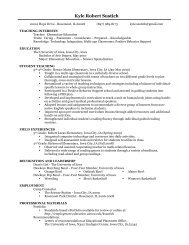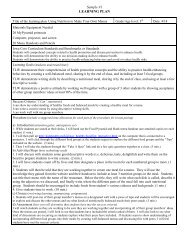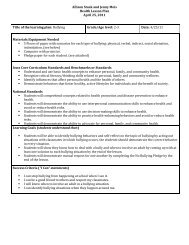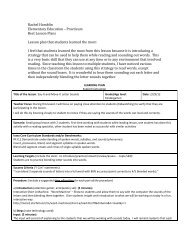Writing child study - Employment
Writing child study - Employment
Writing child study - Employment
You also want an ePaper? Increase the reach of your titles
YUMPU automatically turns print PDFs into web optimized ePapers that Google loves.
trouble coming up with a topic. I told him he could do<br />
anything he wanted, he could make a comic book,<br />
write a story, a poem…just anything he can come up<br />
with. He wanted to write a story about his family<br />
which wasn’t a surprise to me because from the writing<br />
interview and from previous experience with<br />
kidwatching, I knew this was probably coming. I also<br />
observed even with having a topic, usually it was still<br />
hard for him to come up with a story line, characters in<br />
the story, or the setting. Normally he would have no<br />
setting present in the stories he writes.<br />
Recommendations<br />
up with a story line for the story because usually all I can<br />
get out of him is a couple sentences, I printed him off a<br />
graphic organizer to help him organize and generate ideas<br />
because Gretchen said in the beginning of the semester they<br />
were a great teaching tool.<br />
One was a web with the topic in the middle and anything<br />
related to the topic went in the surrounding boxes. I did this<br />
just to get him thinking about unique things about his<br />
family. Buckner says, “people do not see themselves as<br />
writers because they believe they have nothing valuable or<br />
of interest to others to say” (2005, p.9). This is why the first<br />
graphic organizer was so important. It got him thinking<br />
about specific things that his family does so he could see<br />
that if I was interested in these things then anyone else<br />
reading his writing will be too. The next graphic organizer<br />
had boxes for characters, setting, a problem, events, and a<br />
solution. I knew this was an important prewriting strategy<br />
because from previous stories he has written, he only<br />
includes one character, fails to include much detail, and<br />
doesn’t have a beginning middle and end. This tells me he<br />
needs help with building elements in the story and further<br />
exercises with helping him think about these elements in<br />
greater detail. Once we got it all filled out I had him begin<br />
to write his story. Basically when he was done writing the<br />
story all I had was a duplicate of the last graphic organizer<br />
in a different format. Buckner explains, “…students keep a<br />
notebook like a journal—they write in it and that’s the end<br />
of it—your students’ work will improve” (2005, p. 35). The<br />
story Nadjib wrote about his family going to the park I<br />
found out was something they actually do. This makes his<br />
story like a journal of personal experiences. Since it was<br />
pretty basic and only had a beginning, middle, and end with<br />
no detail I knew it was a good start and in the revision<br />
process we would have a good chance to add some details<br />
and make it meatier.<br />
The next step I am going to take is going to come from Buckner’s ideas for adding detail and expanding topics. It<br />
works simply like this: write as many three-word phrases as you possibly can about the topic in three minutes<br />
(Buckner, 2005). I think this will encourage him to think deeper about his story and see how he can fit more detail into<br />
what he already has written. Another thing that would work great for Nadjib that I found out about after we were<br />
already past the revising stage and working on typing the final draft would be to incorporate Hindly’s idea of using<br />
slow motion from her video we watched in class. In this, I would tell him to think about a specific part of the story and<br />
write about it as if it is happening in slow motion. This would help him really think about that one part of the story in<br />
great detail and help him see that detail is important for the reader to be able to imagine what’s going on his story.


